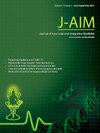Exploration of pharmacological potentialities of Bauhinia acuminata L. fruits by in vitro and in vivo assays supported by computational analysis
IF 1.9
Q3 INTEGRATIVE & COMPLEMENTARY MEDICINE
引用次数: 0
Abstract
Background
In Ayurveda, Bauhinia acuminata L. had been used to treat diabetes, skin diseases, and swelling.
Objective
The study was designed to assess the antidiabetic, anti-inflammatory, and antibacterial potentialities of B. acuminata fruits ethanolic extract. Phytochemical characterization by HPLC analysis, pure compound isolation by column chromatography and in silico analysis were performed.
Methods
Column chromatography was conducted to isolate pure compounds. HPLC analysis was performed using sixteen standard polyphenol s. Three different methods evaluated the antidiabetic effect of the extract. Analgesic property was evaluated. Protein denaturation and formalin-induction tests were done to measure the anti-inflammatory effect. Brewer's yeast-induced pyrexia was followed to assess the antipyretic effect. Antibacterial tests were performed using disc diffusion and anti-biofilm activity assay. Binding interaction was investigated by molecular docking (MD) analysis. Moreover, oral bioavailability and toxicity profiles were analyzed using ADMET assay.
Results
We have isolated β-sitosterol and β-sitosterol-3-O-β-D-glucoside from the extract. Presence of four polyphenols was evident by HPLC analysis. The extract and two isolated compounds showed prominent α-glucosidase inhibition. No mortality and abnormality were found in the acute toxicity test. The extract exhibited good peripheral analgesic and anti-inflammatory properties in a dose-dependent fashion and antipyretic effect. The extract inhibited biofilm formation on the test bacterial colony. MD analysis revealed better binding characteristics of two identified phytosterols, rutin hydrate, and kaempferol with selected protein molecules. ADMET analysis exerted compliance with the compounds except rutin with Lipinski’s rule of five.
Conclusion
The assessment revealed that B. acuminata fruits extract can elicit good antidiabetic, anti-inflammatory, and antibacterial responses.
利用计算分析支持的体外和体内实验研究紫荆果实的药理潜力
在阿育吠陀中,紫荆已被用于治疗糖尿病、皮肤病和肿胀。目的研究荆芥果实乙醇提取物的抗糖尿病、抗炎和抗菌作用。采用高效液相色谱法进行植物化学鉴定、柱层析分离纯化化合物和硅分析。方法采用柱层析法分离纯化化合物。采用16种标准多酚进行高效液相色谱分析,采用3种不同的方法评价其抗糖尿病作用。评估镇痛性能。采用蛋白质变性试验和福尔马林诱导试验测定其抗炎作用。采用酿酒酵母致热法观察解热效果。采用圆盘扩散法和抗生物膜活性法进行抑菌试验。通过分子对接(MD)分析研究了其结合相互作用。此外,采用ADMET法分析口服生物利用度和毒性。结果从提取物中分离得到β-谷甾醇和β-谷甾醇-3- 0 -β- d -葡萄糖苷。高效液相色谱分析证实了四种多酚的存在。提取物和两个分离得到的化合物具有明显的α-葡萄糖苷酶抑制作用。急性毒性试验未见死亡和异常。提取物表现出良好的外周镇痛和抗炎特性,且呈剂量依赖性,具有解热作用。该提取物抑制了试验菌落上生物膜的形成。MD分析显示两种已鉴定的植物甾醇,水合芦丁和山奈酚与选定的蛋白质分子具有较好的结合特性。ADMET分析表明,除芦丁外,其余化合物均符合利平斯基五定律。结论荆刺果提取物具有良好的抗糖尿病、抗炎、抗菌作用。
本文章由计算机程序翻译,如有差异,请以英文原文为准。
求助全文
约1分钟内获得全文
求助全文
来源期刊

Journal of Ayurveda and Integrative Medicine
INTEGRATIVE & COMPLEMENTARY MEDICINE-
CiteScore
4.70
自引率
12.50%
发文量
136
审稿时长
30 weeks
 求助内容:
求助内容: 应助结果提醒方式:
应助结果提醒方式:


